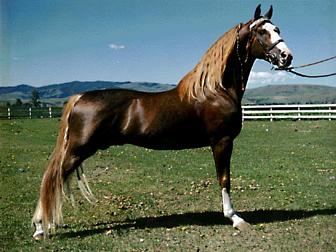
OVERVIEW
The Tennessee Walking Horse's most distinguishing characteristic is its gait, the "Running Walk." This gait was not developed merely for show purposes, but was created to carry the rider in a smooth, comfortable fashion. The Running Walk allows the rider to retain a secure seat involving little exertion or movement. As a result of careful selective breeding of the Tennessee Walker, the running walk is now inherited. This breed also has an even temperament with an excellent disposition. The Tennessee Walking Horse was first bred by farm owners as a strong, comfortable mount on which they could supervise the work in the fields. Now the breed is a distinguished horse more often found in the show ring.
PHYSICAL DESCRIPTION
In general appearance, the Tennessee Walking Horse should have an intelligent look, neat head, well-shaped and pointed ears, clear and alert eyes and a tapered muzzle. The neck should be long and graceful and the shoulders muscular and well sloping. The back should be short with good coupling at the loins. The animal should be deep in the girth and well ribbed and the chest should be of good proportion and width. The croup should be generally sloping and the hips well muscled with muscular development extending down toward the hocks. The legs should be flat and cordy.
ORIGIN
The acknowledged foundation sire of the Tennessee Walking Horse is Allan F-1 (also called Black Allan) who was foaled in Kentucky in 1886. His sire was a Standardbred (Allendorf) and his dam a Morgan (Maggie Marshall). The breed became officially registered in 1935 with the founding of the Tennessee Walking Horse Breeders' and Exhibitors' Association. The breed was originally a type of horse used by farmers and plantation owners for use as a mount in the field where its gait and endurance were highly valued.
INTERESTING FACTS
The particular quality of the Tennessee Walking Horse which attracts such great attention is its gait, the running walk. This gait is made distinct by the fact that the front foot strikes the ground just before the diagonal hind foot. Also, the hind foot oversteps the front foot by 6 to 15 inches. This effectively lowers the hind quarters and provides an extremely smooth ride for the rider at some speed.
INFLUENCES
1. Thoroughbred
2. Narrangansett Pacer
3. Morgan
4. Standardbred
5. Saddlebred
For more information:
Tennessee Walking Horse Breeders' and Exhibitors' Association